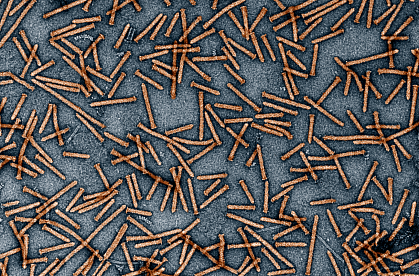You are here
April 11, 2023
Targeted protein delivery using bacterial injection system
At a Glance
- Researchers developed a protein delivery system that can be customized to target specific human cell types.
- The system could be used to deliver gene therapies or cancer therapies safely and efficiently into targeted cells.

Certain bacteria, called endosymbiotic bacteria, live within other organisms. These bacteria have evolved to interact with and influence the biology of their host via various molecular factors. One method for delivering these factors to host cells is the extracellular contractile injection system, or eCIS. eCISs are syringe-like molecular machines with a payload-filled tube that has a spike at one end. A spring-like sheath drives the tube, spike first, through the cell membrane. Once inside the cell, the tube delivers its payload inside the target cell.
The ability of eCISs to target insect cells suggests they might be engineered to deliver proteins to other animal cell types. None thus far have been found to specifically target mammalian cells. How eCISs recognize their target cells has also not been well understood.
A research team led by Dr. Feng Zhang at the Broad Institute and MIT set out to engineer eCISs to target and deliver custom payloads to various mouse and human cell types. They used an eCIS produced by Photorhabdus asymbiotica bacteria. These are insect pathogens that live within parasitic roundworms. Previous studies showed that certain mouse cells can take up eCISs. Procedures for making and purifying eCISs in the laboratory have already been worked out. The findings appeared in Nature on March 29, 2023.
The injection end of the eCIS is ringed with tail fibers, which the team suspected were involved in recognizing target cells. They used AlphaFold, an AI platform that predicts a protein’s structure from its DNA sequence, to predict the tail fibers’ structure. Guided by this information, they attached structures known to bind human cells to the ends of the fibers.
The modified eCIS successfully loaded and delivered its natural payload, a pair of toxins, to human cells in culture. Next, the team swapped out the eCIS’s natural payload for proteins of their choosing. The modified eCIS delivered these custom payloads to human cells as well. In one instance, eCISs carrying gene-editing proteins created targeted edits to the cells’ genome.
The researchers also tried engineering the eCIS to specifically recognize human leukemia cells. When loaded with their natural toxin payload, the eCIS targeted and killed the cells. An eCIS targeting epidermal growth factor receptor (EGFR)—a key factor in the growth of certain cancers—killed cells that made EGFR, but not those without it. These and other findings showed that eCIS could be engineered to target specific types of human cells.
The team next injected eCISs into the brains of live mice. The eCISs safely delivered their payloads to neurons without provoking an immune response.
The findings suggest that eCISs could be used as programmable protein delivery devices that deliver custom protein payloads to specific cells. Potential applications include gene therapy, cancer therapy, and biocontrol. More testing will be needed to assess their potential to deliver therapies in humans.
“Delivery of therapeutic molecules is a major bottleneck for medicine, and we will need a deep bench of options to get these powerful new therapies into the right cells in the body,” Zhang says. “By learning from how nature transports proteins, we were able to develop a new platform that can help address this gap.”
—by Brian Doctrow, Ph.D.
Related Links
- Using Viruses to Treat Antibiotic-Resistant Bacterial Infections
- Targeting Gut Bacteria to Treat Alcoholic Hepatitis
- Engineered Phages Treat Drug-Resistant Infection
- Virus Helps Bacteria Evade Immune System
- Vaccine Protects Animals Against Anthrax and Plague
- Method Can Target Specific Microbes
- How CRISPR Is Changing Cancer Research and Treatment
References: Programmable protein delivery with a bacterial contractile injection system. Kreitz J, Friedrich MJ, Guru A, Lash B, Saito M, Macrae RK, Zhang F. Nature. 2023 Mar 29. doi: 10.1038/s41586-023-05870-7. Online ahead of print. PMID: 36991127.
Funding: NIH’s National Cancer Institute (NCI) and National Human Genome Research Institute (NHGRI); Poitras Center for Psychiatric Disorders Research at MIT; Hock E. Tan and K. Lisa Yang Center for Autism Research at MIT; K. Lisa Yang and Hock E. Tan Molecular Therapeutics Center at MIT; K. Lisa Yang Brain–Body Center at MIT; Human Frontier Science Program; Howard Hughes Medical Institute; Broad Institute Programmable Therapeutics Gift Donors; Pershing Square Foundation; William Ackman; Neri Oxman; J. and P. Poitras; Kenneth C. Griffin; BT Charitable Foundation; Asness Family Foundation; Phillips family; D. Cheng; R. Metcalfe.
